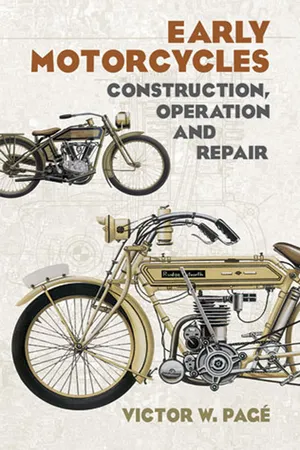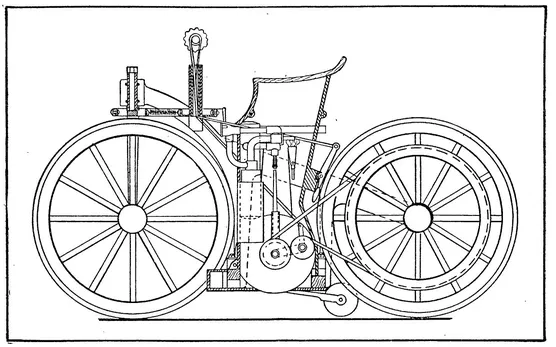![]()
CHAPTER I.
MOTORCYCLE DEVELOPMENT AND DESIGN.
Why Motorcycles are Popular—How Motorcycles Developed from the Bicycle-Somo Pioneer Motorcycles and Influence on Present Design—Causes of Failures in Early Types—Mechanical Features of Early Forms—The Demand for More Power—Essential Requirements of Practical Motorcycles—Motorcycles of Various Types—Light—Weight vs. Medium-Weight Construction—Determining Power Needed—In—fluence of Road Surface on Traction—How Speed Affects power Needed —Effect of Air Resistance—How Gradients Affect Power Required—Power in Proportion to Weight—Influence of Modern Automobile Practice—The Modern Motorcycle, Its Parts and Their Functions—General Characteristics Common to all Forms—Some Modern Motorcycle Designs.
The motorcycle has been aptly termed the “poor man’s automobile” and to one fully familiar with self-propelled vehicles, this term is no misnomer. The modern machine, with its ease of control, its reliability, its power and speed will carry one or two passengers more economically than any other method of transportation. Fitted with a side-car attachment, it becomes a practical vehicle for general use, as the body may be suited for passenger or commercial service. The demand for motorcycles, side cars and delivery vans has created an industry of magnitude that furnishes a livelihood for thousands of skilled workmen, and unmeasurable pleasure for hundreds of thousands who would be deprived of the joys of motoring were it not for the efficiency and low cost of operation of the vehicle that carries them swiftly and comfortably over the highways. The development of the motor bicycle dates back farther than that of the motor car, and it was demonstrated to be a practical conveyance over three decades ago, though it is only within the past six or eight years that this single-track, motor-propelled vehicle has attracted the attention its merits deserve.
17
Why Motorcycles are Popular.—The automobile attracted the attention of the public for some time before the motorcycle became generally popular, and, as a consequence, the development of the larger vehicle was more rapid for a time. As the early buyers of motor cars were of the class to which money is no object, as long as personal wishes are gratified, most of the manufacturers then building bicycles, to whom the public naturally looked for motorcycles, devoted their energies and capital to the design and corstruction of automobiles rather than motorcycles, because the pro: pect for immediate profits seemed greater in catering to the great demand that existed for any kind of automobile that would run at all. The development of the motorcycle was left to people, for the most part, without the requisite engineering knowledge or manufacturing facilities, so, naturally, the growth of the industry was of little moment until an equally insistent demand made itself felt for motorcycles, at which time people with capital began to consider the production of two-wheeled vehicles with favor. The demand for bicycles had been diminishing for several years, and the new type, with motor attached, seemed to offer a field that could be cultivated to advantage.
The evanescent popularity of the bicycle and the rapid rise to almost universal use, with almost as rapid decline was construed as a warning to proceed slowly in building.motorcycles, as many thought the future of the motorcycle would be doubtful and that it was merely a passing fad. The bicycle required the expenditure of considerable energy, and, while very valuable as an exerciser, it did not offer pleasure enough for the bulk of our population in proportion to the amount of effort involved in making trips really worth while. The application of mechanical power, however, removed that objection, so the only deterring factor to the ready adoption of the motor-propelled bicycle was a lack of confidence on the part of the public regarding its reliability. It was not long before the endurance and practicability of the motorcycle was established beyond doubt, and as soon as the advantages began to be given serious consideration, a healthy demand, which is growing in importance yearly, stimulated its development from a crude makeshift to a practical and safe method of personal transportation.
The motorcycle and its various combinations with fore cars and side cars appeals to a conservative element who consider the cost of maintenance and operation fully as much as the initial expense of acquiring it. The motorcycle really has many fundamental advantages to commend it, as it has the speed and radius of action of the most powerful motorcar, with a lower cost of upkeep than any other vehicle of equal capacity. As constructed at the present time, the motorcycle is not only low in first cost, but its simplicity makes it an ideal mount for all desiring motor transportation at the least expense. The mechanism of the motorcycle, its control and repair, are readily understood by any person of average intelligence, and with the improved materials and processes employed in its manufacture, combined with the refinement of design and careful workmanship, a thoroughly practical and serviceable motor vehicle is produced which sells at but a slightly higher price than the first high-grade safety bicycles of fifteen years ago. At the present time, the motorcycle is not only popular for pleasure purposes, but it is applied to many industrial and commercial applications that insure a degree of permanency in popular estimation never possible with the bicycle.
How Motorcycles Developed from Bicycles.—Many of the mechanics who turned their attention to motorcycle construction were thoroughly familiar with bicycle practice of the period and, as considerable progress had been made in building light machines that possessed great strength for foot propulsion, it was but natural that the regular form of diamond frame bicycle should be adapted to motor propulsion by the attachment of a simple power plant and auxiliary devices. As a concession to mechanical power, various parts of the machine, such as the front forks, the rims and tires, and in some cases the frame tubes were made slightly heavier, but in essentials the first motorcycles to be made commercially followed bicycle practice, and with power plant removed, it would be difficult to tell them from the heavy built tourist models of pedal cycles. Naturally, the motor and tanks were not always disposed to the best advantage, and for considerable time, as the writer will show, much thought was spent in endeavoring to combine the widely varying principles found in bicycle and motorcycle practice and devise a hybrid machine composed of all the parts of the ordinary bicycle, with the various components of the gasoline or internal combustion power plant disposed about the frame at any point where attachment was possible. The motorcycle of the present day follows automobile principles and is radically different from its earlier prototypes in practically every respect except a general family resemblance owing to the use of two wheels, handle bar control, pedals for starting and placing a saddle so the rider can keep his balance to better advantage by sitting astride as on the bicycle.
Some Pioneer Motorcycles and Influence on Present Design. —As early as 1885, Gottlieb Daimler, who constructed the first practical high-speed internal combustion engine, and who, for this reason, is known as “the Father of the Automobile,” obtained a patent on a two-wheel vehicle shown at Fig. 1. This, while not beautiful in outline, was a practical motor-propelled conveyance, and may be justly regarded as the forerunner of the modern motorcycle. In fact, in general arrangement of parts, this pioneer design is not unlike the modern product. At that time, the only motor vehicles regarded as practical or capable of actual operation for limited distances were types propelled by electric or steam power, and it will thus be apparent that Daimler’s crude motor bicycle was not only the foundation of the motorcycle industry but also formed a basis for the development of the automobile which, in its most successful form, employs the internal combustion motor as a source of power.
Fig. 1.—Early Model of the Daimler Motorcycle, the Parent of All Present Day Self-Propelled Vehicles.
After numerous designs in which single cylinder motors played a part, in 1889, Daimler patented a double inclined cylinder motor, the first multiple cylinder conception. This original form is that from which the modern V-engine, so widely used at the present time for cycle propulsion, was derived. This creation was also the first to be made in any considerable number and, even at this late day, some of the original Daimler engines are still operated. In this design, the cylinders were inclined but 15 degrees, and eccentric grooves turned in the fly-wheel face were utilized to operate the exhaust valves, instead of the cam motion which is now common. The cylinder was cooled by an enclosed fan wheel which supplied a current of air confined around the cylinder by a jacket, so the first practical high-speed internal combustion engine was cooled by air. This is the method used almost universally in the case of the bicycle motor, even at the present day.
After a time other motors appeared, such as the De Dion motor tricycles, propelled by a small engine based on Daimler lines, and which were more reliable than the first steam coaches and much superior to the early electric vehicles in all important essentials such as radius of operation, cost, reliability and speed. To Daimler must also be given credit for the invention of the first practical carburetor, or device to produce a combustible gas from liquid fuel, also an important factor in the development of the automobile.
The first Daimler machine, which is shown at Fig. 1, with one side of the frame removed, was not unlike the modern loop-frame machine in important respects. While the wheels were placed rather close together, the motor placing was intelligently thought out, and was so installed that the center of gravity was brought closer to the ground than in many of the machines which succeeded it. The drive from the pulley on the motor crankshaft to a larger member on the rear wheel and the use of a jockey pulley or belt tightener to obtain a clutching effect has not been altered in principle since its first application by Daimler. Steering was accomplished by a steering head construction practically the same as on present-day machines. The early form of Daimler motor did not have very much flexibility on account of the sluggish action of the vaporizer and the ignition by hot tubes so the speed was varied largely by allowing the driving belt to slip and by applying the brake. This was done by a controller wheel carried by a standard just in front of the operator’s seat. When this was rotated in one direction, the jockey pulley or idler was allowed to drop, so that the belt became loose while a spoon brake, working on the rear wheel tire, was applied progressively as the belt tension was diminished, and consequently the driving power was reduced.
Fig. 2.—Early Daimler Motorcycle With Countershaft Drive.
A later form of Daimler bicycle, in which a countershaft was used, is shown at Fig. 2. The drive from the motor crankshaft to a pulley comprising one member of the countershaft assembly was by belt while a small spur gear provided a further reduction in speed by engaging an internal gear attached to the rear wheel spokes. It will be evident that Daimler not only originated the direct drive motorcycle but that he was also responsible for the first conception of the countershaft drive form. Attention is directed to the use of the auxiliary wheels mounted on each side of the rear driving member to steady the machine and keep it upright when not in motion. The lines of either of the Daimler machines are not unlike the forms we are familiar with, and the resemblance is striking enough, so that the parentage of the modern motorcycle can...


